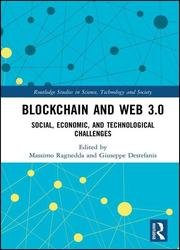Blockchain and Web 3.0: Social, Economic, and Technological Challenges
- Добавил: literator
- Дата: 5-07-2020, 17:56
- Комментариев: 0
 Название: Blockchain and Web 3.0: Social, Economic, and Technological Challenges
Название: Blockchain and Web 3.0: Social, Economic, and Technological Challenges Автор: Massimo Ragnedda, Giuseppe Destefanis
Издательство: Routledge
Год: 2020
Страниц: 334
Язык: английский
Формат: pdf (true)
Размер: 10.1 MB
Blockchain is no longer just about bitcoin or cryptocurrencies in general. Instead, it can be seen as a disruptive, revolutionary technology which will have major impacts on multiple aspects of our lives. The revolutionary power of such technology compares with the revolution sparked by the World Wide Web and the Internet in general. Just as the Internet is a means of sharing information, so blockchain technologies can be seen as a way to introduce the next level: sharing value.
The problem solved by a blockchain is “consensus”. It revolutionizes the concept of trust, introducing elements for generating disruption in the financial sector. Currencies are therefore the first concept which can be implemented upon such technology, but this is only the premise. Satoshi Nakamoto conceived the Bitcoin electronic cash system in 2008 with the aim of producing digital coins whose control is distributed across the Internet rather than owned by a central issuing authority such as a government or a bank. It became fully operational in January 2009, when the first mining operation was completed, and since then it has continuously seen an increase in the number of users and miners. In the beginning, the interest in the bitcoin digital currency was purely academic, and the exchanges in bitcoins were limited to a restricted elite of people more interested in the cryptography properties than in the real bitcoin value. Nowadays bitcoins are exchanged to buy and sell real goods and services, as happens with traditional currencies.
The main distinctive feature introduced by the Bitcoin system is the distributed infrastructure where all the transfers are recorded. To send and receive bitcoins, a user needs an alphanumeric code called an address. An address can be seen as a bank account number and can be the recipient of funds. An address is public information derived from a public key. No personal information is recorded in a blockchain, and for this reason, the Bitcoin protocol offers pseudo-anonymity.
Скачать Blockchain and Web 3.0: Social, Economic, and Technological Challenges
[related-news] [/related-news]
Внимание
Уважаемый посетитель, Вы зашли на сайт как незарегистрированный пользователь.
Мы рекомендуем Вам зарегистрироваться либо войти на сайт под своим именем.
Уважаемый посетитель, Вы зашли на сайт как незарегистрированный пользователь.
Мы рекомендуем Вам зарегистрироваться либо войти на сайт под своим именем.
